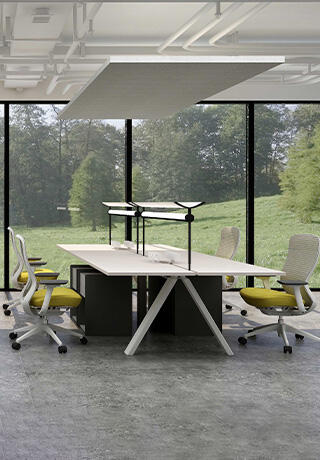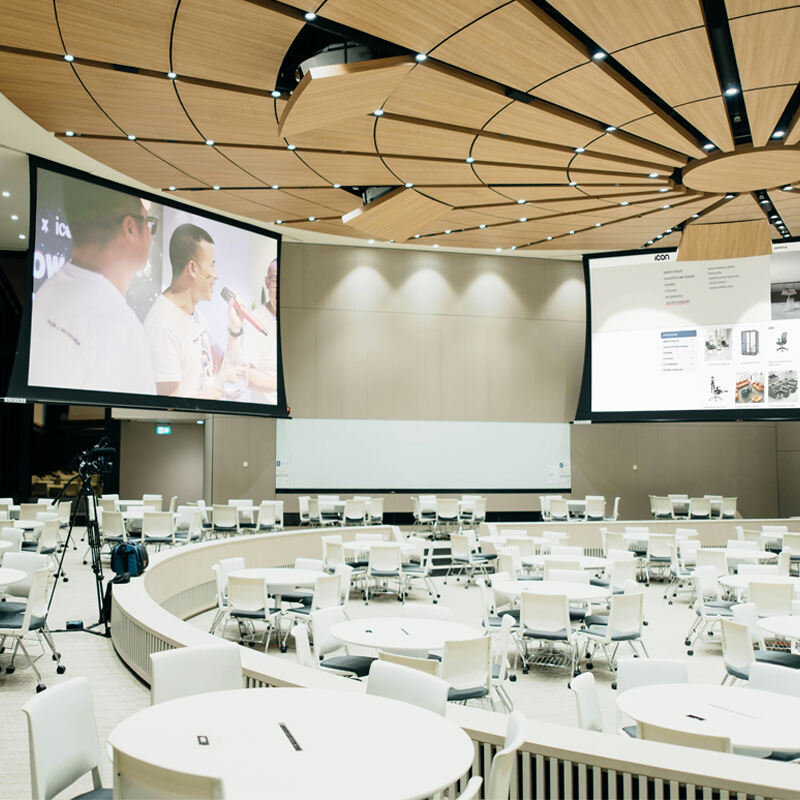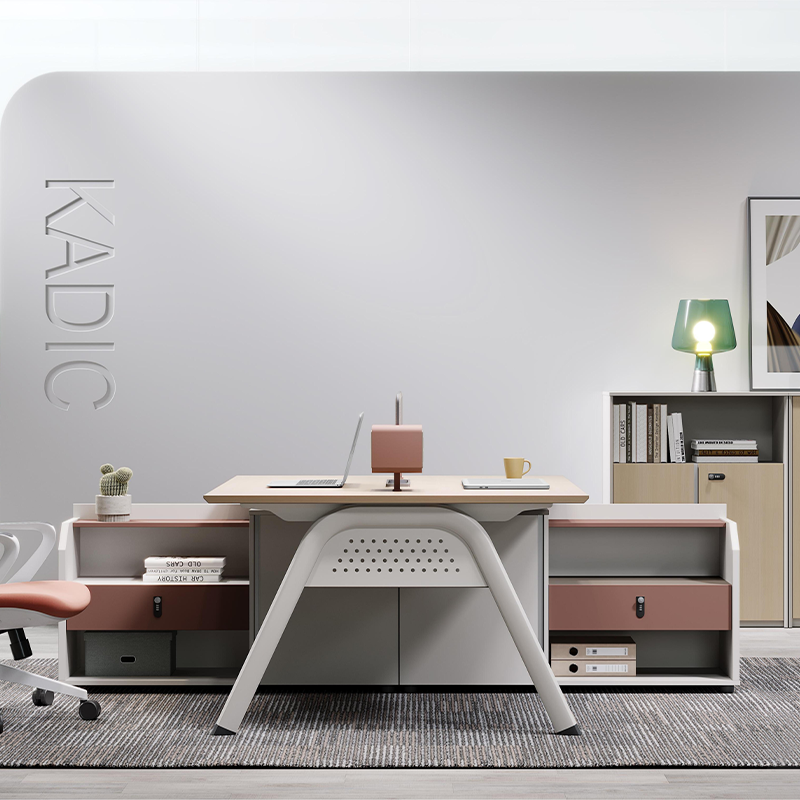I små arbetsutrymmen – oavsett om det är ett hörn i sovrummet, ett litet hemmakontor eller ett delat vardagsutrymme – ett skrivbord måste dO mer än bara att hålla en bärbar dator. Den måste maximera varje tum av utrymme, anpassa sig till flera uppgifter och undvika att kännas rörig. Ett funktionellt skrivbord för små utrymmen balanserar storlek, förvaring och mångsidighet, och omvandlar även de trängsta områdena till produktiva arbetszoner. Låt oss utforska de viktigaste egenskaperna som gör ett skrivbord fungerar i små miljöer, så att det stöder effektivitet utan att dominera rummet.
Kompakta mått utan att offra arbetsyta
Den första kännetecknet för ett funktionellt skrivbord för små arbetsutrymmen är dess storlek: det måste passa in i ytan samtidigt som det erbjuder tillräckligt med arbetsyta. Ett för stort skrivbord kommer att dominera rummet, men ett som är för litet kan göra att du har svårt att få plats med nödvändiga föremål som till exempel en monitor eller en anteckningsbok.
Ideal bredd och djup
För små utrymmen är den perfekta balansen ett skrivbord med en bredd på 100–120 cm och ett djup på 60–70 cm. Detta erbjuder tillräckligt med plats för en bärbar dator eller monitor, en mus och en liten hög med papper utan att ta för mycket plats. För ännu trängre utrymmen (till exempel en smal korridor eller garderobskontor) fungerar ett smalt skrivbord (75–90 cm bred och 45–50 cm djupt), även om detta kan kräva att man prioriterar det nödvändigaste (till exempel bara en bärbar dator, ingen extra monitor).
Väggföljande design
Ett skrivbord som placeras tätt mot väggen - istället för att sväva i mitten av rummet - sparar värdefull golvarea. Leta efter skrivbord med raka kanter och inga utskjutande delar (såsom tjocka armstöd eller överhäng) som slösar bort plats. Hörnskrivbord, som är designade för att passa i 90 graders vinklar, är särskilt smarta för små arbetsutrymmen eftersom de utnyttjar hörn som annars skulle gå förlorade. Deras L-form ger större arbetsyta än ett rakt skrivbord med samma bottenarea, där ena sidan kan användas för en skärm och den andra för skrivning eller material.
Höjde överväganden
En standardhöjd på ett skrivbord (74–76 cm) fungerar för de flesta, men i små utrymmen kan ett något lägre skrivbord (69–71 cm) skapa illusionen av mer vertikal plats, vilket gör att rummet känns mindre trångt. Men prioritera ergonomi: skrivbordet måste fortfarande tillåta att armbågarna vilar i en 90 graders vinkel när man skriver, för att förhindra belastning även i en kompakt miljö.
Flerfunktionella egenskaper för att maximera användbarheten
I små arbetsutrymmen måste ett skrivbord ha dubbla funktioner för att motivera sin närvaro. Funktionala skrivbord för trånga utrymmen kombinerar ofta arbetsytor med förvaring eller förvandlas till annan möbel när de inte används, vilket eliminerar behovet av extra möbler.
Konverterbara och fällbara design
Fällbara skrivbord är spelväxlare för små utrymmen. Dessa skrivbord monteras på väggen eller viks ihop när de inte används, vilket frigör golvutrymme. Till exempel kan ett väggmonterat skrivbord med klaff vikas ihop till 2–3 tum tjockt, och förvandlas till en elegant dekorativ detalj när det är stängt, och sedan öppnas till en fullstor arbetsyta under dagen. Vissa modeller kan till och med förvandlas till matbord eller konsolbord, vilket gör dem idealiska för studiolägenheter där en möbel måste kunna fylla flera funktioner.
Inbyggd Förvaring Integration
Ett funktionalt skrivbord för små arbetsutrymmen utnyttjar det vertikala utrymmet för förvaring, vilket minskar behovet av separata skåp eller hyllor. Leta efter:
- Skrivbord med hyllor ovanför (fästa vid väggen ovanför skrivbordet) för böcker, växter eller en sekundär skärm.
- Lådor eller fack under skrivbordet för att förvara pennor, laddare och pappersarbete. Smala, vertikala lådor (i stället för breda) spar djup och passar bra under ett grunt skrivbord.
- Magnetstrimmor eller lödbrädor monterade på väggen ovanför skrivbordet för att hålla verktyg, saxar eller anteckningar, och hålla skrivbordsytan fri.
Dessa funktioner gör skrivbordet till ett självständigt arbetsutrymme, där allt du behöver är inom räckhåll men inte skapar oordning i området.

Justerbar höjd för versatilitet
Ett skrivbord med höjdbar höjd (även ett kompakt) förbättrar funktionaliteten i små utrymmen genom att anpassas till olika uppgifter. Sänk ner bordet för att använda det som matbord eller extra arbetsyta, och höj det sedan till arbetslåg när det behövs. Denna flexibilitet är särskilt värdefull i studior, där samma område kan fungera som hemma kontor, matsal och vardagsrum. Elektriska modeller med minnesfunktion gör det enkelt att byta höjd, medan manuella vridbord är mer budgetvänliga.
Smart organisering och kabelhantering t
I små arbetsutrymmen sprider sig oreda snabbt, vilket gör organisering avgörande. Ett funktionellt skrivbord har funktioner som håller material, kablar och papper under kontroll, så att området känns öppet och effektivt.
Lösningar för kabelläggning
Små utrymmen lämnar liten plats att dölja fula kablar, så ett skrivbord med inbyggd kabelhantering är nödvändigt. Leta efter:
- Kabelföringar (hål i skrivbordsytan) för att leda kablar från skärmen eller bärbara datorn ner till en förlängningsskena nedanför.
- Under-skrivbordsfack eller klämmor för att samla kablar och laddare, för att förhindra att de hänger löst eller snurrar in sig.
- Inbyggda vägguttag integrerade i skrivbordet, vilket eliminerar behovet av en separat uttagsskena på golvet.
Dessa funktioner håller kablarna osynliga, vilket gör att skrivbordsområdet känns renare och mer öppet.
Minimalistisk design för att undvika visuell oreda
Ett skrivbord med enkel, strömlinjeformad design (utan dekorativa ben eller massiva konstruktioner) är att föredra i små utrymmen. Glas- eller ljusa träskrivbord skapar en känsla av öppenhet, eftersom de inte visuellt tynger ner rummet. Undvik skrivbord med överflödiga detaljer (t.ex. snidade kanter eller tjocka ben), eftersom dessa kan göra utrymmet känslomässigt trångt. Ett väggfäst skrivbord – monterat på väggen utan synliga ben – går ännu längre och skapar illusionen av mer golvyta genom att lämna området nedanför fritt (perfekt för att placera en liten pall eller en förvaringslåda).
Zonbaserad ytteknisk planering
Även ett litet skrivbord kan kännas funktionellt om dess yta är indelad i zoner: en för datorn/skärmen, en för skrivning och en liten plats för nödvändigheter som en kaffemugg. Denna genomtänkta layout förhindrar att föremål sprider sig, vilket gör att skrivbordet upplevs större än det är. Att använda skrivbordsorganisatorer (t.ex. en liten bricka för pennor, en stativ för datorn) håller varje zon i ordning och säkerställer att varje tum används på bästa sätt.
Hållfasthet och Viktshållighet
Ett funktionellt skrivbord för små arbetsutrymmen måste vara tillräckligt stabilt för att hålla dagliga nödvändigheter – dator, skärm, böcker – utan att vackla eller uppta extra plats med en klumpig konstruktion. Material och konstruktion spelar roll, även i kompakta design.
Lättviktiga men stabila material
Skrivbord för små utrymmen använder ofta lätta material som aluminium, bambu eller konstruerat trä, som är lätta att flytta och inte tillför visuell tyngd. Dock måste de fortfarande kunna bära vikt: ett kvalitetsbord bör klara minst 50–75 pounds (tillräckligt för en monitor, bärbar dator och några böcker). Leta efter bord med förstärkta konstruktioner (t.ex. metallbeslag eller tvärbalkar) för att förhindra böjning, även när de belastas.
Rumsbesparende benkonstruktioner
Bordsben kan slösa bort värdefullt utrymme i små ytor. Välj bord med:
- Smalnande eller vinklade ben som går under skrivbordet och lämnar mer plats för att sträcka ut benen eller förvara en liten kassett under.
- Hårnålsben (smala metallben med en minimalistisk design) som upptar lite visuellt utrymme och gör att bordet känns lättare.
- Väggmonterade ben (för flytande bord) som helt eliminerar kontakt med golvet och frigör utrymmet nedanför för förvaring eller rörelse.
Dessa bensystem säkerställer att endast själva bordet upptar golvyta, inte klumpiga stöd.
Estetisk integration med rummet
I små arbetsutrymmen kan skrivbordet inte kännas som en eftertanke – det måste smälta in med rummets dekoration för att undvika en stötande, rörd uppfattning. Ett funktionellt skrivbord för små utrymmen kompletterar den befintliga stilen, vilket gör att arbetsutrymmet känns genomtänkt och sammanhållet.
Matcha rummets stil
Ett skrivbord som ansluter till rummets design (t.ex. modern, bohemiansk eller industriell) känns som en del av utrymmet, inte som en störning. Till exempel:
- Ett stilrent vitt skrivbord med metallben passar ett minimalistiskt sovrum.
- Ett träbord med naturlig yta fungerar bra i ett mysigt vardagsrum.
- Ett fällbart skrivbord med ett färgglatt laminattopplägg ger personlighet åt en liten vrå utan att dominera den.
När skrivbordet matchar rummet bidrar det till en känsla av harmoni, vilket gör det lilla utrymmet att kännas större och mer genomtänkt.
Visuell lätthet
Ljusa färger (vita, pasteller, ljus trä) och transparenta material (glas, akryl) gör att ett skrivbord känns mindre dominanta i små utrymmen. Ett glastoppsbord skapar exempelvis en illusion av plats genom att låta ljuset passera igenom, medan ett vitt skrivbord reflekterar ljuset och förbättrar belysningen i området. Dessa val förhindrar att skrivbordet dominerar rummet, även i trånga kvarterslägen.
Vanliga frågor: Funktionella skrivbord för små arbetsutrymmen
Vilken är den minsta funktionala skrivbordsstorleken?
Ett skrivbord med en bredd på 30 tum och djup på 18 tum kan fungera för grundläggande uppgifter (datoranvändning, skrivning). Det är trångt men hanterbart om du prioriterar det nödvändiga. För dubbla skärmar eller fler tillbehör rekommenderas ett skrivbord som är 40 tum bred och 24 tum djup.
Kan ett litet skrivbord ändå stödja en monitor och en bärbar dator?
Ja, om den är stabil. Leta efter små skrivbord med en viktbärförmåga på minst 22 kg. Ett skrivbord som är 91 cm brett kan rymma en 61 cm monitor och en bärbar dator sida vid sida, med plats för en mus. Monitors som monteras på vägg (med armar) frigör ytterligare skrivbordsyta.
Hur gör jag för att lägga till förvaring i ett litet skrivbord utan att det blir trångt?
Använd vertikala lösningar: montera hyllor ovanför skrivbordet, lägg till en hängande mapporganisatör eller använd stapelbara containrar under bordet. Magnetiska skrivbordsaccessoarer (pennalette, anteckningsbrädor) håller ytor fria, medan fackindelare maximerar utrymmet i små lådor.
Är ett höjningsbart skrivbord värt det för ett litet arbetsutrymme?
Ja – många höjningsbara skrivbord finns i kompakta storlekar (102–122 cm brett). De spar utrymme genom att eliminera behovet av en separat matta för stående (du kan stå direkt framför) och uppmuntrar rörelse, vilket är avgörande i trånga utrymmen där du annars skulle sitta i timmar.
Hur gör jag för att få ett litet skrivbord att kännas mindre trångt?
Håll ytan 70 % fri (endast nödvändiga föremål framme), använd ljusa färger och lägg till en liten spegel i närheten för att reflektera ljus. Kablar är nyckeln – att dölja dem öppnar omedelbart upp utrymmet. Välj också ett skrivbord med öppna ben (inte stängda skåp) för att skapa visuell rörelsefrihet.
Innehållsförteckning
-
I små arbetsutrymmen – oavsett om det är ett hörn i sovrummet, ett litet hemmakontor eller ett delat vardagsutrymme – ett skrivbord måste dO mer än bara att hålla en bärbar dator. Den måste maximera varje tum av utrymme, anpassa sig till flera uppgifter och undvika att kännas rörig. Ett funktionellt skrivbord för små utrymmen balanserar storlek, förvaring och mångsidighet, och omvandlar även de trängsta områdena till produktiva arbetszoner. Låt oss utforska de viktigaste egenskaperna som gör ett skrivbord fungerar i små miljöer, så att det stöder effektivitet utan att dominera rummet.
- Kompakta mått utan att offra arbetsyta
- Ideal bredd och djup
- Väggföljande design
- Höjde överväganden
- Flerfunktionella egenskaper för att maximera användbarheten
- Konverterbara och fällbara design
- Inbyggd Förvaring Integration
- Justerbar höjd för versatilitet
- Smart organisering och kabelhantering t
- Lösningar för kabelläggning
- Minimalistisk design för att undvika visuell oreda
- Zonbaserad ytteknisk planering
- Hållfasthet och Viktshållighet
- Lättviktiga men stabila material
- Rumsbesparende benkonstruktioner
- Estetisk integration med rummet
- Matcha rummets stil
- Visuell lätthet
-
Vanliga frågor: Funktionella skrivbord för små arbetsutrymmen
- Vilken är den minsta funktionala skrivbordsstorleken?
- Kan ett litet skrivbord ändå stödja en monitor och en bärbar dator?
- Hur gör jag för att lägga till förvaring i ett litet skrivbord utan att det blir trångt?
- Är ett höjningsbart skrivbord värt det för ett litet arbetsutrymme?
- Hur gör jag för att få ett litet skrivbord att kännas mindre trångt?





